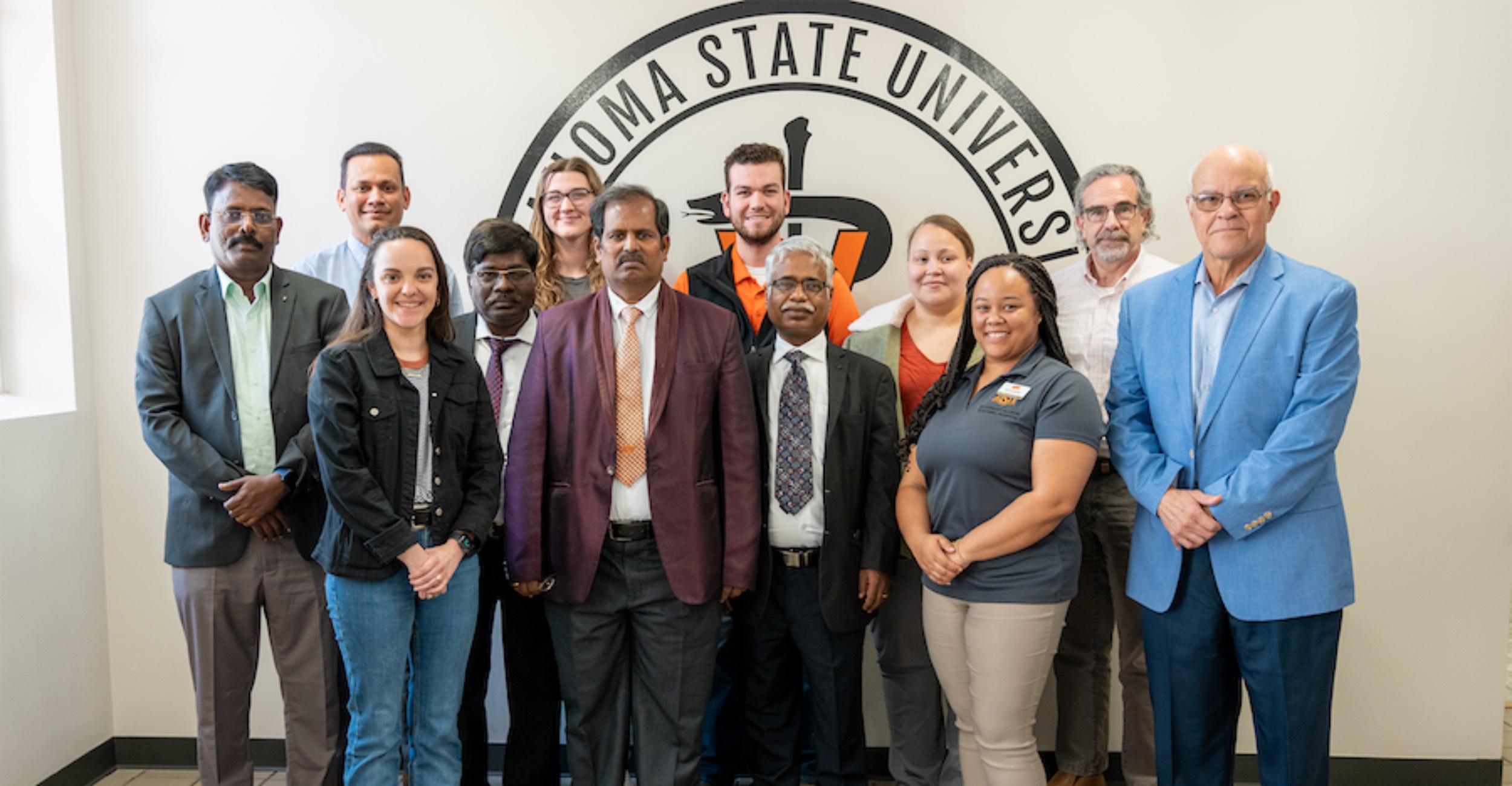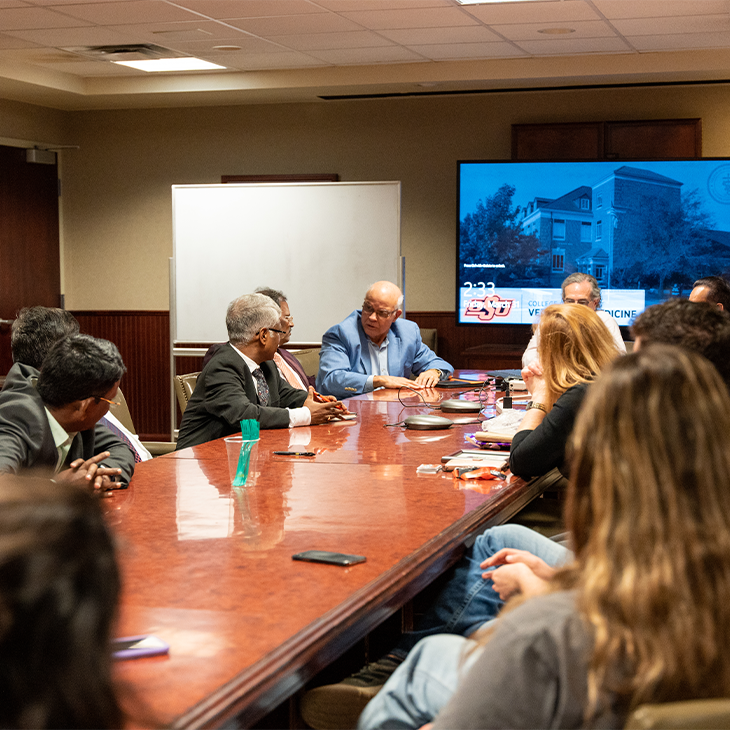
A Global Focus: OSU College of Veterinary Medicine helps shape veterinary practice in India
Thursday, May 25, 2023
Media Contact: Kelli Norton | Communication Specialist | 405-744-5496 | kelli.norton@okstate.edu
Oklahoma State University’s College of Veterinary Medicine (OSU-CVM) is having an impact on veterinary medicine in India, especially through its relationship with Tamil Nadu University of Veterinary and Animal Sciences (TANUVAS).
This partnership allows OSU faculty and students to learn more about the challenges
of animal health internationally and to share their expertise to help improve training
in India. As part of this collaboration, 10 OSU-CVM students will travel to TANUVAS
this summer to learn more about the challenges of animal health in India.
These challenges can be immense. While the average veterinarian in the U.S. working
in a hospital setting may see 15 patients on a typical day, a veterinarian in India
might see 40 patients per day. Demand for services is expected to increase by 7-10%
annually through 2027. In addition, performing multiple diagnostic tests per patient,
which might be standard in the U.S., are not a luxury that veterinarians in India
can rely on due to time and expense. The 10 OSU-CVM students — Kaitlyn Cole, Alli
Garcia, Tamara Kastner, Victoria Mitchell, Corie Platt, Maddy Rao, Hannah Rolo, Brie
Shillingford, Braden Steidley and Madison Tryzbiak — will get a crash course in snap
diagnoses.
“The rate of deployment of advances in diagnostics that we have here in America versus
what they have overseas is sometimes not comparable,” Shillingford said. “Bringing
both worlds together through collaboration will hopefully lead to compatible diagnostic
tools for veterinarians around the world and will teach us the ability to manage care
without them. Being able to handle veterinary medicine without advanced technology
is a beneficial skill to have, especially working with animals.”
One Health, as defined by the CDC and other research organizations, is a term that
is used to refer to the interaction of human, animal, and environmental health and
involves a cooperative, transdisciplinary approach to working locally, nationally
and globally. In other words, by improving animal health, human health is also improved,
and vice versa.
As a member of the American Association of Veterinary Medical Colleges (AAVMC), OSU-CVM’s
international collaborations are one example of how the college fulfills the One Health
initiative challenged by the association. AAVMC One Health also partners with the
Association of Public and Land-Grant Universities (APLU), of which OSU is also a member.
Dr. Carlos Risco, dean of the College of Veterinary Medicine, said the AAVMC encourages
U.S. colleges of veterinary medicine to globalize and expand veterinary medical education
and research internationally.
The goal is for each veterinary school [in the U.S.] to partner with others internationally to learn from each other. That's what we're doing with the exchange of students and faculties in research and the effort to standardize curriculum so that the veterinary school curriculum is aligned in the U.S. and India. So the question is, how can we align the curriculum? Also, the mission of our college, as a land grant university, is to advance research, particularly in One Health. So this is a tremendous opportunity we have to partner with them.
Dr. Ashish Ranjan is the director of OSU’s Institute for Translational and Emerging Research in Advanced Comparative Therapy (INTERACT), which brings together the One Health mission of OSU by bringing together clinicians, researchers and scientists conducting research in areas including oncology, infectious diseases, parasitology, reproductive and emerging diseases of small and large animals. He said OSU-CVM offers unique experiences not available to students at veterinary colleges anywhere else in the U.S., such as the student exchange program with TANUVAS.

The students from India and the U.S. take the lessons learned back to their countries
after their time abroad and use them in their veterinary studies and care.
“It is important to see how different species of animals around the world are often
used for the same purposes — milk production, meat production, pets and companion
animals,” said Dr. Jerry Malayer, senior associate dean of the College of Veterinary
Medicine. “Also, each country has diverse endemic diseases. The U.S. does a lot of
disease surveillance so that exotic diseases don't enter the country. Sometimes, if
you're traveling overseas, you see cases that you can't see here. In 10, 20 or 30
years, if that disease spreads here, and these students have seen it, they may not
recognize it immediately, but they’ll have some idea that they're looking at something
new and different. Without this experience, they would have less to go on.”
Faculty exchange is also an important part of the collaboration. In the spring of
2023, four TANUVAS faculty members — Dr. Krishnakumar Karuppasamy, Dr. Chandrasekar
Muniswamy, Dr. Arunkumar Selvarayar and Dr. Thamil Vanan Thangarajan — spent time
observing at OSU and say they are taking several experiences back and implementing
them into their practices and how they teach veterinary students.
“We feel empowered with many new techniques and new knowledge,” Thangarajan said.
“This will help to improve how we teach our students, improve the extension program
and make new avenues available for students to research. We learned a lot from this
university, and it will be helpful. We thank the dean, senior associate dean, and
administration for the opportunity. We are indebted and grateful to them. We learned
these things quickly, but we expect to learn more if the training is extended.”
The visiting faculty from India and the leadership of OSU-CVM plan to achieve much
more in their partnership.
“As Dean Risco stated, this is only the beginning, and we are excited about our plans
with this partnership and where they will take us,” Thangarajan said.
Story By: Kelli Leech, OSU Global graduate assistant | kelli.leech@okstate.edu
